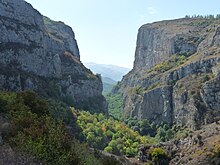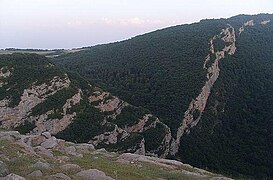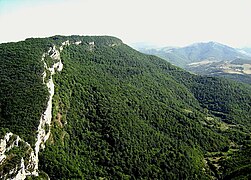| Revision as of 03:36, 2 February 2015 view sourceParishan (talk | contribs)Autopatrolled, Extended confirmed users13,427 editsNo edit summary← Previous edit | Latest revision as of 00:46, 7 November 2024 view source Monkbot (talk | contribs)Bots3,695,952 editsm Task 20: replace {lang-??} templates with {langx|??} ‹See Tfd› (Replaced 1);Tag: AWB | ||
| (90 intermediate revisions by 38 users not shown) | |||
| Line 1: | Line 1: | ||
| {{short description|Azeri woodland}} | |||
| {{Orphan|date=November 2014}} | |||
| {{pp|small=yes}} | |||
| {{Use dmy dates|date=February 2018}} | |||
| ] | |||
| The '''Topkhana Forest''' ({{langx|az|Topxana meşəsi}}) is a forest<ref> {{Webarchive|url=https://web.archive.org/web/20190517121728/http://shusha.az/susa-rayonun-%C9%99razisi-v%C9%99-t%C9%99bii-ehtiyatlari/ |date=17 May 2019 }}.</ref> and a state reserve located near ], ].<ref> {{Webarchive|url=https://web.archive.org/web/20181021151408/http://www.qam.az/az/azerbaycanin-isgal-olunmus-erazilerinde-meselerin-mehv-edilmesi-barede-faktlar-aciqlanib |date=21 October 2018 }}. Karabakh Research Centre. Azeri Community of Nagorno-Karabakh.</ref><ref>{{Cite web |url=http://www.gomap.az/Info/Description.aspx?idlo=116&lvo=3&pID=1519946 |title=Topxana Meşəsi Dövlət Qoruğu |access-date=2 February 2015 |archive-date=23 November 2015 |archive-url=https://web.archive.org/web/20151123031717/http://www.gomap.az/Info/Description.aspx?idlo=116&lvo=3&pID=1519946 |url-status=live }}</ref> Claims of its destruction in 1988 caused tensions over the political future of ] and encouraged civil and inter-ethnic unrest that would eventually erupt into the ]. | |||
| ⚫ | ==History== | ||
| The '''Topkhana Forest''' ({{lang-az|Topxana meşəsi}}) is a forest and a state reserve located near ], ].<ref></ref> Claims of its destruction in 1988 caused tensions over the political future of ] and encouraged civil and inter-ethnic unrest that would eventually erupt into the ]. | |||
| Topkhana is the name of a gently-sloping hillside opposite (and visible from) the town of Shusha, but separated from the town by deep gorge containing the Karkar (also known as the Dashalty) river. Its name derives from it being the location of cannons ("top" in Turkic languages) of ] during his siege of Shusha in 1795.<ref>Bakour Karapetyan, "The Roots of the Karabagh Problem", page 163.</ref> The forest was mentioned in ]'s novel ''The Last Night of the Expiring Year'' first published in 1970.<ref>Anar Rzayev. ''Последняя ночь уходящего года''. In: Suleyman Valiyev. Горжусь тобой, мой Азербайджан (anthology of novels by Azerbaijani writers). Azarnashr: Baku, 1970.</ref> Yevgeni Kotlyarov, USSR Master of Sports and specialist on athletic tourism, mentioned "forested slopes of the Topkhana plateau in Shusha" in his 1978 publication on mountain tourism in Karabakh.<ref>Yevgeny Kotlyarov. География отдыха и туризма: формирование и развитие территориальных рекреациаонных комплексов. Mysl': Moscow, 1978.</ref> In his book of critical reviews of Soviet literature, published in 1985, writer ], who spent his younger years in Shusha, mentioned "staring into the dark blue depth of the mighty Topkhana forest" as a youth and "dreaming of having first novel published".<ref>Elchin Afandiyev. {{Webarchive|url=https://web.archive.org/web/20180417152841/http://anl.az/el_ru/alf26/e_pp.pdf |date=17 April 2018 }}. Sovetsky Pisatel': Moscow, 1987 (translated edition).</ref> In early November 1988, the site was described by ] as home to "just one rather spindly tree and some scrubby bushes".<ref>Yuri Rost, ''Armenian Tragedy''. London, Weidenfeld & Nicolson, 1990. Page 78.</ref> | |||
| ==Claims of destruction== | |||
| ==Background== | |||
| ] | |||
| ⚫ | In October 1988 ], the First Secretary of the ], announced in a speech that a bridge should be constructed across the Hunot Gorge in order to expand the town of Shusha onto the opposite bank and link it to the surrounding countryside. Shusha was predominantly Azerbaijani-populated, but the opposite bank was inhabited exclusively by Armenians, who considered this was an attempt to expand Azerbaijani-inhabited territory in Nagorno-Karabakh at the expense of its Armenian population. The ] decided a symbolic Armenian-held structure should be erected on that opposite bank, and on 5 November consulted with the Central Committee of the ], who, in return for an assurance that the upcoming ] parade in ] would not be disrupted, agreed to send trucks loaded with building materials for the construction. The trucks and materials arrived in Shusha on 7 November. This (in the ]) was the ] - but Shusha had been placed under curfew and the usual Communist parades and ceremonies had been cancelled.<ref>Yuri Rost, ''Armenian Tragedy''. London, Weidenfeld & Nicolson, 1990, pages 74-77.</ref> | ||
| ⚫ | In some sources the proposed structure is described as a workshop, in most it is described as a recreational facility for workers at Yerevan's ] aluminium factory.{{fact|date=July 2020}} | ||
| ⚫ | In October 1988 ], the First Secretary of the ], announced in a speech that a bridge should be constructed across the Hunot Gorge in order to expand the town of Shusha onto the opposite bank and link it to the surrounding countryside. Shusha was predominantly |
||
| ⚫ | On 9 November 1988 construction work began at Topkhana on a vacation resort for workers at Yerevan's Kanaker aluminium factory. Permission for the work had been granted by the civic authorities of nearby ], who had designated 15 acres of land for the project.{{fact|date=July 2020}} <!-- However, the authorities in ] were incensed that they had not been asked to give permission and the Azerbaijani government halted the construction<ref>Mark Malkasian, "Gha-ra-bagh!: The Emergence of the National Democratic Movement in Armenia", p169. Wayne State University Press, 1996.</ref> and had the building materials removed from the site. Yuri Rost considered that this demonstration of control from Baku indicated to even the most passive inhabitants of Nagorno-Karabakh that there would be no political or economic reforms without secession from Azerbaijan. Marc Malkasian describes it as a "major symbolic skirmish". --> | ||
| ⚫ | In some sources the proposed structure is described as a workshop, in most it is described as a recreational facility for workers at Yerevan's ] aluminium factory. | ||
| ⚫ | The halting of the construction was accompanied by an "atmosphere of hysteria" erupting in Baku, fed by inaccurate information printed in local Baku newspapers, none of which had actually sent a reporter to Shusha. Nationalists had taken control of the Azerbaijani press, publishing stories that a "sacred grove" had been destroyed by Armenians who were going to build an aluminium plant. The aim was to stir up popular pro-Azerbaijani and anti-Armenian sentiments. An editorial in Bakinskiy Rabochiy (Baku Worker) called the construction a "branch of the Kanakerskiy Aluminum Plant", the location the "Topkhan Natural History Museum of living nature", and asserted that for Azerbaijanis, Topkhana was "the final drop that made the cup of patience overflow".<ref>] Report: "Soviet Union Political Affairs", 13 February 1989, page 60.</ref><ref>Stuart J. Kaufman, "Modern Hatreds: The Symbolic Politics of Ethnic War". p67.</ref> Azerbaijan radio claimed that Topkhane was a "historical natural monument" and the site of an Azerbaijani fortress. <!-- In the words of Malkasian, "a rather nondescript hill became a sacred forest in Baku media" as a "product of Transcaucasia's overheated political atmosphere". --> The result was an organized Azerbaijani popular movement emerging for the first time in the growing Nagorno-Karabagh crisis<ref>Stuart J. Kaufman, "Modern Hatreds: The Symbolic Politics of Ethnic War", p66.</ref> and, starting on 17 November, large-scale demonstrations began in Baku's ] to protest against the supposed destruction at Topkhana. The 17 November event is now commemorated as a national holiday in Azerbaijan, known as "National Revival Day".<ref>1992 Azerbaijani law defining official holidays: AZƏRBAYCAN RESPUBLİKASININ QANUNU. 1992-ci il, 27 oktyabr {{cite web |url=http://e-qanun.az/print.php?internal=view&target=1&docid=7874&doctype=0 |title=Archived copy |accessdate=2014-11-22 |url-status=dead |archiveurl=https://web.archive.org/web/20141129154037/http://e-qanun.az/print.php?internal=view&target=1&docid=7874&doctype=0 |archivedate=29 November 2014 |df=dmy-all }}</ref> | ||
| ⚫ | ==History== | ||
| ⚫ | <!-- As the Baku demonstrations continued, they became increasingly Islamic and increasingly anti-Armenian, with chants of "death to the Armenians"<ref>Mark Malkasian, "Gha-ra-bagh!: The Emergence of the National Democratic Movement in Armenia", p170. Wayne State University Press, 1996.</ref> and demands that those convicted of the murder of Armenians during the ] be released. The demonstrations also developed into an anti-central government, anti-Soviet protest. On November 23 a curfew was imposed in Baku: as Soviet troops tried unsuccessfully to disperse the crowds, attacks on Armenians and their homes became more numerous. Civil unrest also spread to other towns in Azerbaijan with Armenian minorities, ].. --> | ||
| ⚫ | Azerbaijani sources still maintain that the Baku reports of November 1988 about Topkhana are true, describing the forest as "a true miracle of nature", claiming "here lived plants, bears, wolves, wild boars, foxes, hares, deer, quail, pigeons, a variety of other animals and birds. Along the forest stretched sub-alpine and alpine meadows, deep gorges and springs dazzled the imagination. It is estimated that more than 2,000 oak trees and other rare species of trees have been felled at Topkhana and transported to Armenia. Its rich flora and fauna continue to be destroyed."<ref>{{Cite web|url=http://portal.azertag.az/ru/node/1085#.VE5HI_msVr8|title=Лес Топхана|access-date=27 October 2014|archive-date=17 February 2020|archive-url=https://web.archive.org/web/20200217015715/http://portal.azertag.az/ru/node/1085#.VE5HI_msVr8|url-status=live}}</ref> | ||
| Topkhana is the name of a gently-sloping hillside opposite (and visible from) the town of Shusha, but separated from the town by deep gorge containing the Karkar (also known as the Dashalti) river. Its name derives from it being the location of cannons ("top" in Turkish) of ] during his siege of Shusha in 1795.<ref>Bakour Karapetyan, "The Roots of the Karabagh Problem", page 163.</ref> In early November 1988, before any construction had happened, the site was described by ] as home to "just one rather spindly tree and some scrubby bushes".<ref>Yuri Rost, "Armenian Tragedy". London, Weidenfield and Nicolson, 1990. Page 78.</ref> | |||
| == Gallery == | |||
| ⚫ | On |
||
| <gallery mode="packed" size=180> | |||
| File:Topkhana Forest.jpg | |||
| ⚫ | The halting of the construction was accompanied by an "atmosphere of hysteria" erupting in Baku, fed by inaccurate information printed in local Baku newspapers, none of which had actually sent a reporter to Shusha. Nationalists had taken control of the Azerbaijani press, publishing stories that a "sacred grove" had been destroyed by Armenians who were going to build an aluminium plant. The aim was to stir up popular pro-Azerbaijani and anti-Armenian sentiments. An editorial in Bakinskiy Rabochiy (Baku Worker) called the construction a "branch of the Kanakerskiy Aluminum Plant", the location the "Topkhan Natural History Museum of living nature", and asserted that for Azerbaijanis, Topkhana was "the final drop that made the cup of patience overflow".<ref>] Report: "Soviet Union Political Affairs", 13 February 1989, page 60.</ref><ref>Stuart J. Kaufman, "Modern Hatreds: The Symbolic Politics of Ethnic War". p67.</ref> Azerbaijan radio claimed that Topkhane was a "historical natural monument" and the site of an Azerbaijani fortress. In the words of Malkasian, "a rather nondescript hill became a sacred forest in Baku media" as a "product of Transcaucasia's overheated political atmosphere". The result was an organized Azerbaijani popular movement emerging for the first time in the growing Nagorno-Karabagh crisis<ref>Stuart J. Kaufman, "Modern Hatreds: The Symbolic Politics of Ethnic War", p66.</ref> and, starting on |
||
| File:Topkhana Forest 1.jpg | |||
| File:Topkhana Forest 2.jpg | |||
| ⚫ | As the Baku demonstrations continued, they became increasingly Islamic and increasingly anti-Armenian, with chants of "death to the Armenians"<ref>Mark Malkasian, "Gha-ra-bagh!: The Emergence of the National Democratic Movement in Armenia", p170. Wayne State University Press, 1996.</ref> and demands that those convicted of the murder of Armenians during the ] be released. The demonstrations also developed into an anti-central government, anti-Soviet protest. On November 23 a curfew was imposed in Baku: as Soviet troops tried unsuccessfully to disperse the crowds, attacks on Armenians and their homes became more numerous. Civil unrest also spread to other towns in Azerbaijan with Armenian minorities, |
||
| File:Topkhana Forest 3.jpg | |||
| </gallery> | |||
| ⚫ | Azerbaijani sources still maintain that the Baku reports of November 1988 about Topkhana are true, describing the |
||
| ==Notes== | ==Notes== | ||
| {{Reflist}} | {{Reflist}} | ||
| {{coord missing|Azerbaijan}} | |||
| ] | ] | ||
| ⚫ | ] | ||
| ] | ] | ||
| ⚫ | ] | ||
Latest revision as of 00:46, 7 November 2024
Azeri woodland

The Topkhana Forest (Azerbaijani: Topxana meşəsi) is a forest and a state reserve located near Shusha, Azerbaijan. Claims of its destruction in 1988 caused tensions over the political future of Nagorno-Karabakh and encouraged civil and inter-ethnic unrest that would eventually erupt into the first Nagorno-Karabakh War.
History
Topkhana is the name of a gently-sloping hillside opposite (and visible from) the town of Shusha, but separated from the town by deep gorge containing the Karkar (also known as the Dashalty) river. Its name derives from it being the location of cannons ("top" in Turkic languages) of Mohammad Khan Qajar during his siege of Shusha in 1795. The forest was mentioned in Anar Rzayev's novel The Last Night of the Expiring Year first published in 1970. Yevgeni Kotlyarov, USSR Master of Sports and specialist on athletic tourism, mentioned "forested slopes of the Topkhana plateau in Shusha" in his 1978 publication on mountain tourism in Karabakh. In his book of critical reviews of Soviet literature, published in 1985, writer Elchin Afandiyev, who spent his younger years in Shusha, mentioned "staring into the dark blue depth of the mighty Topkhana forest" as a youth and "dreaming of having first novel published". In early November 1988, the site was described by Galina Starovoitova as home to "just one rather spindly tree and some scrubby bushes".
Claims of destruction

In October 1988 Abdurrahman Vazirov, the First Secretary of the Communist Party of Azerbaijan, announced in a speech that a bridge should be constructed across the Hunot Gorge in order to expand the town of Shusha onto the opposite bank and link it to the surrounding countryside. Shusha was predominantly Azerbaijani-populated, but the opposite bank was inhabited exclusively by Armenians, who considered this was an attempt to expand Azerbaijani-inhabited territory in Nagorno-Karabakh at the expense of its Armenian population. The Karabakh Committee decided a symbolic Armenian-held structure should be erected on that opposite bank, and on 5 November consulted with the Central Committee of the Communist Party of Armenia, who, in return for an assurance that the upcoming October Revolution parade in Yerevan would not be disrupted, agreed to send trucks loaded with building materials for the construction. The trucks and materials arrived in Shusha on 7 November. This (in the Gregorian calendar) was the anniversary of the October 1917 revolution - but Shusha had been placed under curfew and the usual Communist parades and ceremonies had been cancelled.
In some sources the proposed structure is described as a workshop, in most it is described as a recreational facility for workers at Yerevan's Kanaker aluminium factory.
On 9 November 1988 construction work began at Topkhana on a vacation resort for workers at Yerevan's Kanaker aluminium factory. Permission for the work had been granted by the civic authorities of nearby Askeran, who had designated 15 acres of land for the project.
The halting of the construction was accompanied by an "atmosphere of hysteria" erupting in Baku, fed by inaccurate information printed in local Baku newspapers, none of which had actually sent a reporter to Shusha. Nationalists had taken control of the Azerbaijani press, publishing stories that a "sacred grove" had been destroyed by Armenians who were going to build an aluminium plant. The aim was to stir up popular pro-Azerbaijani and anti-Armenian sentiments. An editorial in Bakinskiy Rabochiy (Baku Worker) called the construction a "branch of the Kanakerskiy Aluminum Plant", the location the "Topkhan Natural History Museum of living nature", and asserted that for Azerbaijanis, Topkhana was "the final drop that made the cup of patience overflow". Azerbaijan radio claimed that Topkhane was a "historical natural monument" and the site of an Azerbaijani fortress. The result was an organized Azerbaijani popular movement emerging for the first time in the growing Nagorno-Karabagh crisis and, starting on 17 November, large-scale demonstrations began in Baku's Lenin Square to protest against the supposed destruction at Topkhana. The 17 November event is now commemorated as a national holiday in Azerbaijan, known as "National Revival Day".
Azerbaijani sources still maintain that the Baku reports of November 1988 about Topkhana are true, describing the forest as "a true miracle of nature", claiming "here lived plants, bears, wolves, wild boars, foxes, hares, deer, quail, pigeons, a variety of other animals and birds. Along the forest stretched sub-alpine and alpine meadows, deep gorges and springs dazzled the imagination. It is estimated that more than 2,000 oak trees and other rare species of trees have been felled at Topkhana and transported to Armenia. Its rich flora and fauna continue to be destroyed."
Gallery
Notes
- Territory, natural resources, historical and cultural landmarks of the Shusha District Archived 17 May 2019 at the Wayback Machine.
- Facts Discovered with Regard to the Destruction of Forests in the Occupied Parts of Azerbaijan Archived 21 October 2018 at the Wayback Machine. Karabakh Research Centre. Azeri Community of Nagorno-Karabakh.
- "Topxana Meşəsi Dövlət Qoruğu". Archived from the original on 23 November 2015. Retrieved 2 February 2015.
- Bakour Karapetyan, "The Roots of the Karabagh Problem", page 163.
- Anar Rzayev. Последняя ночь уходящего года. In: Suleyman Valiyev. Горжусь тобой, мой Азербайджан (anthology of novels by Azerbaijani writers). Azarnashr: Baku, 1970.
- Yevgeny Kotlyarov. География отдыха и туризма: формирование и развитие территориальных рекреациаонных комплексов. Mysl': Moscow, 1978.
- Elchin Afandiyev. Поле притяжения Archived 17 April 2018 at the Wayback Machine. Sovetsky Pisatel': Moscow, 1987 (translated edition).
- Yuri Rost, Armenian Tragedy. London, Weidenfeld & Nicolson, 1990. Page 78.
- Yuri Rost, Armenian Tragedy. London, Weidenfeld & Nicolson, 1990, pages 74-77.
- JPRS Report: "Soviet Union Political Affairs", 13 February 1989, page 60.
- Stuart J. Kaufman, "Modern Hatreds: The Symbolic Politics of Ethnic War". p67.
- Stuart J. Kaufman, "Modern Hatreds: The Symbolic Politics of Ethnic War", p66.
- 1992 Azerbaijani law defining official holidays: AZƏRBAYCAN RESPUBLİKASININ QANUNU. 1992-ci il, 27 oktyabr "Archived copy". Archived from the original on 29 November 2014. Retrieved 22 November 2014.
{{cite web}}: CS1 maint: archived copy as title (link) - "Лес Топхана". Archived from the original on 17 February 2020. Retrieved 27 October 2014.
Categories:



